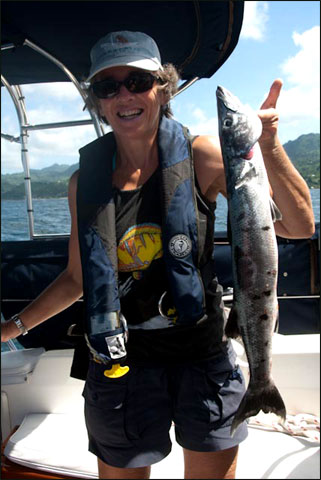 |
|
Dinner that I reeled in between Carriacou and Grenada.
Barracuda. Delicious. |
Almost every night we're home, we set the table (see below) and sit down to dinner, usually in the main salon but sometimes in the cockpit. On Receta , dinner is the one meal that is definitely NOT catch-as-catch-can. I mostly cook from scratch (with the help of the odd can or jar), focusing on what's available fresh locally.
If I've been to the Saturday market in Port of Spain, Trinidad, say, dinner might be curried shrimp with rice and a salad. If we're in Grenada and fishermen friends have stopped by with fresh lambi (conch), we might cook it in foil on the barbecue (using my recipe in An Embarrassment of Mangoes) or stew it in the pressure cooker and serve it with rice and “creamed” callaloo (using the method a Grenadian friend taught me, which is included in The Spice Necklace .)
And, of course, we cook fish whenever we can buy it, catch it, or are given it as a gift – pan-fried, grilled, curried, you name it. (We eat red meat onboard very infrequently.)
We set the table with place mats and use cloth napkins (from Art Fabrik in Grenada), except when we're eating a dish that requires our fingers, like lobster or crab. (Then we revert to paper towels.)
I do most of the cooking on Receta , because I enjoy it -- though Steve is in charge when dinner is on the grill. (He also has a few stove specialties, including a fabulous Creole octopus.) The tradition on Receta is that I wash, Steve dries, and both of us put away – usually with some lively soca, calypso, or steel-pan accompaniment.
Breakfast and lunch are more casual. We usually have fruit and cereal for breakfast (with either yogurt – sometimes homemade – or UHT milk), and, occasionally, fresh-baked muffins (such as the papaya-banana muffins in An Embarrassment of Mangoes (see recipe here). Lunch if we're onboard is usually a quick sandwich. |